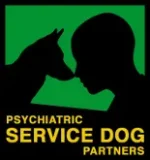You've likely seen a sweet-looking guide dog leading its handler around streets and stores before and you may have wondered, "Can I pet that dog?"
In short, the answer is no. If you see a dog wearing a harness, vest, or cape, assume it's working. Service dogs provide mobility, guidance, comfort, and companionship for their handlers and interfering with what the team is doing could result in a potentially dangerous situation. This National Service Dog Awareness month, we wanted to remind you of best practices to follow when you're around a service dog to ensure everyone stays safe. This is what happens to service dogs when they retire.
There are many reasons you shouldn't pet service dogs, including:
It's distracting the dog from its job
You wouldn't try to distract and engage an air traffic controller talking to them to get their attention while he or she is working, would you? No! That would be dangerous. The same goes for a service dog. When you see it out and about, assume it's working and on-duty to keep its handler safe.
"If people in the general public either pet, talk to, make eye contact with any assistance dog, it can distract the animal from its work and then the dog is going to not pay attention to tasks it needs to perform,"' says Rivi Israel, guide dog program manager, Guide Dog Foundation & America's VetDogs. That can also distract the handler and put their safety in jeopardy.
By petting a service dog, talking to it, or trying to offer it food, you're detracting it from its ability to give its full attention to keeping its handler safe. "A lot of people have balance issues and if the dog moves in one direction because it's accepting a greeting from a stranger and the handler isn't fully aware of it, it can throw the person off balance and caused them to fall," says CJ Betancourt MD, executive director, The Foundation for Service Dog Support.
Making eye contact could be just as distracting
A lot of people don't really think that even making eye contact with the service dog is a distraction, but it actually is because if the dog looks you in the eyes it could lose focus on his/her job, says Israel. "We teach the dogs at our foundation to avoid distraction whether it be a person with a pet dog or somebody trying to feed the dog or pet it," says Israel. Even if they've received excellent training, they're still dogs first and sometimes can't help but practice instinctual behaviors.
The dog is working, even if it's not doing anything
There are a number of jobs a service dog is trained to do, depending on the handlers' needs—and many of these are invisible. Some handlers need their dogs to get them medicine, to notice seizures, to be aware of a scent that indicates rapidly decreasing blood sugar levels for a diabetic, or, to sense if their handler is uncomfortable and about to experience a PTSD episode. Even if a service dog is sleeping, assume it's working (and don't wake it up from its nap! Who wants that?). And never ask a handler what their disability is, advises Israel.
It could be against the law in your state
OK, we know that you wouldn't do this, but if someone tries to maliciously or recklessly interfere with or impede the duties performed by a guide dog or service dog, that could be a misdemeanor offense or even a class 6 felony, in some states, including in Arizona.
You could get hurt
Just because a dog is wearing a service vest or ID, it doesn't mean they are a trained service dog. "Unfortunately there are more illegitimate service teams than there are legitimate teams these days," says Dr. Betancourt. If you're interacting with a dog that's not professionally trained to be a service dog, it could bite you or harm you. You never want to put yourself in a position to potentially be harmed so always practice caution. That being said, you should assume any service dog you see is legitimate and "working" so let it do its job.
In short, the answer is no. If you see a dog wearing a harness, vest, or cape, assume it's working. Service dogs provide mobility, guidance, comfort, and companionship for their handlers and interfering with what the team is doing could result in a potentially dangerous situation. This National Service Dog Awareness month, we wanted to remind you of best practices to follow when you're around a service dog to ensure everyone stays safe. This is what happens to service dogs when they retire.
There are many reasons you shouldn't pet service dogs, including:
It's distracting the dog from its job
You wouldn't try to distract and engage an air traffic controller talking to them to get their attention while he or she is working, would you? No! That would be dangerous. The same goes for a service dog. When you see it out and about, assume it's working and on-duty to keep its handler safe.
"If people in the general public either pet, talk to, make eye contact with any assistance dog, it can distract the animal from its work and then the dog is going to not pay attention to tasks it needs to perform,"' says Rivi Israel, guide dog program manager, Guide Dog Foundation & America's VetDogs. That can also distract the handler and put their safety in jeopardy.
By petting a service dog, talking to it, or trying to offer it food, you're detracting it from its ability to give its full attention to keeping its handler safe. "A lot of people have balance issues and if the dog moves in one direction because it's accepting a greeting from a stranger and the handler isn't fully aware of it, it can throw the person off balance and caused them to fall," says CJ Betancourt MD, executive director, The Foundation for Service Dog Support.
Making eye contact could be just as distracting
A lot of people don't really think that even making eye contact with the service dog is a distraction, but it actually is because if the dog looks you in the eyes it could lose focus on his/her job, says Israel. "We teach the dogs at our foundation to avoid distraction whether it be a person with a pet dog or somebody trying to feed the dog or pet it," says Israel. Even if they've received excellent training, they're still dogs first and sometimes can't help but practice instinctual behaviors.
The dog is working, even if it's not doing anything
There are a number of jobs a service dog is trained to do, depending on the handlers' needs—and many of these are invisible. Some handlers need their dogs to get them medicine, to notice seizures, to be aware of a scent that indicates rapidly decreasing blood sugar levels for a diabetic, or, to sense if their handler is uncomfortable and about to experience a PTSD episode. Even if a service dog is sleeping, assume it's working (and don't wake it up from its nap! Who wants that?). And never ask a handler what their disability is, advises Israel.
It could be against the law in your state
OK, we know that you wouldn't do this, but if someone tries to maliciously or recklessly interfere with or impede the duties performed by a guide dog or service dog, that could be a misdemeanor offense or even a class 6 felony, in some states, including in Arizona.
You could get hurt
Just because a dog is wearing a service vest or ID, it doesn't mean they are a trained service dog. "Unfortunately there are more illegitimate service teams than there are legitimate teams these days," says Dr. Betancourt. If you're interacting with a dog that's not professionally trained to be a service dog, it could bite you or harm you. You never want to put yourself in a position to potentially be harmed so always practice caution. That being said, you should assume any service dog you see is legitimate and "working" so let it do its job.















